Zara Strategic Appraisal Report
VerifiedAdded on 2019/10/18
|24
|4844
|623
Report
AI Summary
This report offers a comprehensive strategic appraisal of Zara, a prominent Spanish clothing brand. It begins with an introduction and company background, followed by a thorough external analysis using PESTEL and Porter's Five Forces frameworks. The internal analysis utilizes the value chain model, competency framework, and VRIO framework to identify Zara's strengths and weaknesses. The report then delves into Zara's corporate and business strategies, examining its generic strategy and position on the strategy clock. Key issues and challenges faced by Zara are discussed, followed by an exploration of strategic growth options using the Ansoff matrix and TOWS matrix. The report concludes with recommendations for Zara's future strategic direction and a summary of its overall performance and competitive position. Appendices include visual representations of the analytical frameworks used.
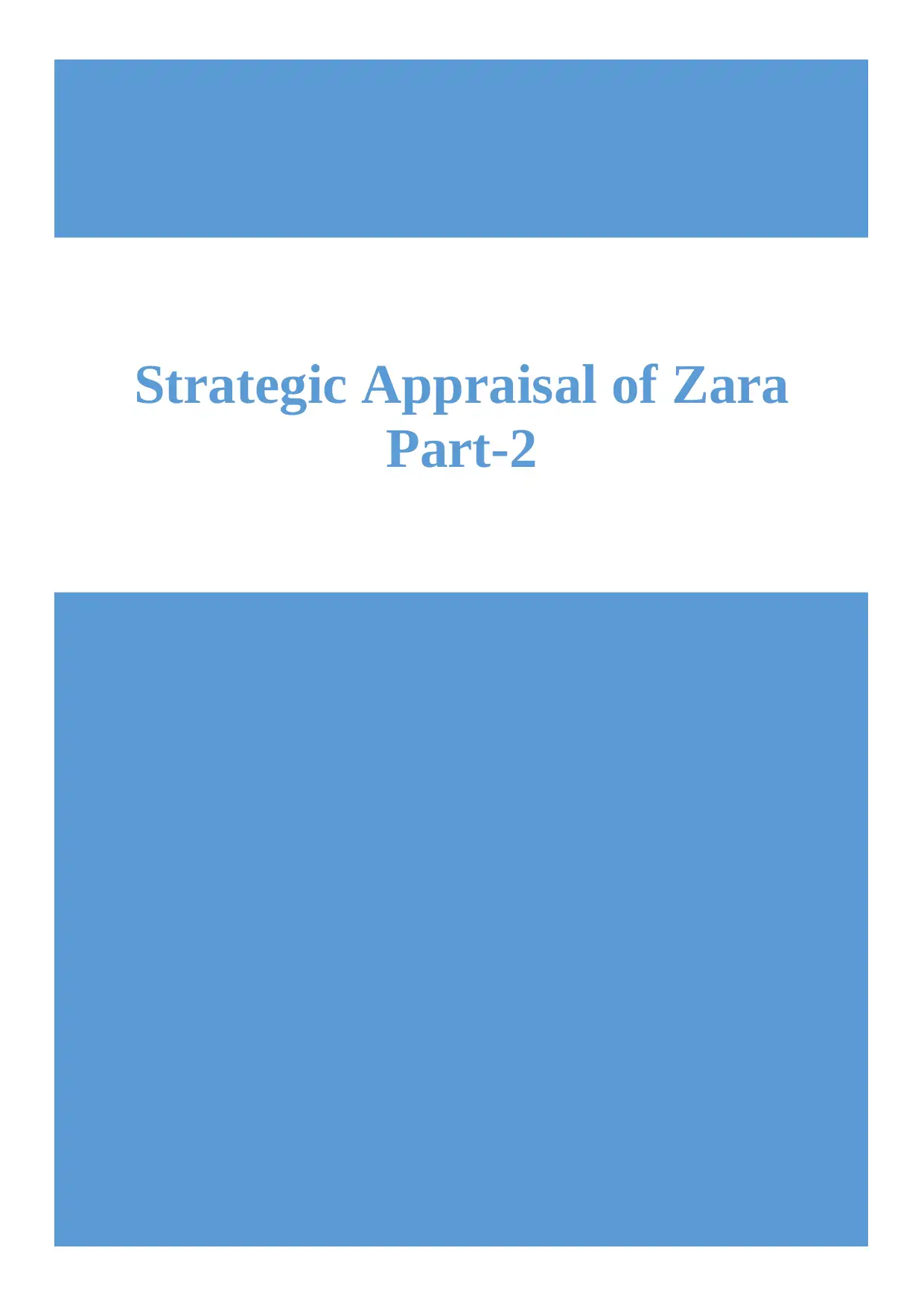
Strategic Appraisal of Zara
Part-2
Part-2
Paraphrase This Document
Need a fresh take? Get an instant paraphrase of this document with our AI Paraphraser
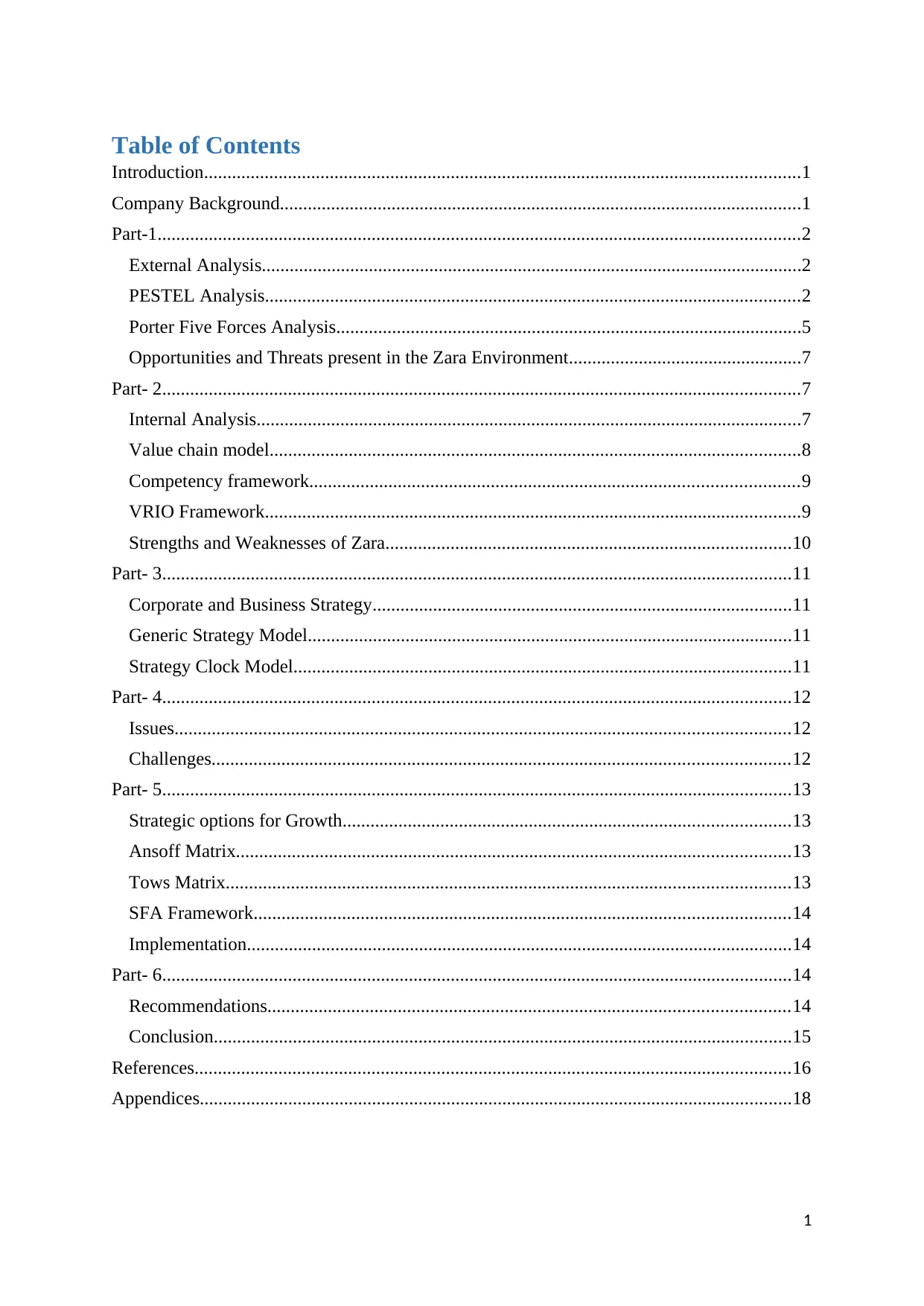
Table of Contents
Introduction................................................................................................................................1
Company Background................................................................................................................1
Part-1..........................................................................................................................................2
External Analysis....................................................................................................................2
PESTEL Analysis...................................................................................................................2
Porter Five Forces Analysis....................................................................................................5
Opportunities and Threats present in the Zara Environment..................................................7
Part- 2.........................................................................................................................................7
Internal Analysis.....................................................................................................................7
Value chain model..................................................................................................................8
Competency framework.........................................................................................................9
VRIO Framework...................................................................................................................9
Strengths and Weaknesses of Zara.......................................................................................10
Part- 3.......................................................................................................................................11
Corporate and Business Strategy..........................................................................................11
Generic Strategy Model........................................................................................................11
Strategy Clock Model...........................................................................................................11
Part- 4.......................................................................................................................................12
Issues....................................................................................................................................12
Challenges............................................................................................................................12
Part- 5.......................................................................................................................................13
Strategic options for Growth................................................................................................13
Ansoff Matrix.......................................................................................................................13
Tows Matrix.........................................................................................................................13
SFA Framework...................................................................................................................14
Implementation.....................................................................................................................14
Part- 6.......................................................................................................................................14
Recommendations................................................................................................................14
Conclusion............................................................................................................................15
References................................................................................................................................16
Appendices...............................................................................................................................18
1
Introduction................................................................................................................................1
Company Background................................................................................................................1
Part-1..........................................................................................................................................2
External Analysis....................................................................................................................2
PESTEL Analysis...................................................................................................................2
Porter Five Forces Analysis....................................................................................................5
Opportunities and Threats present in the Zara Environment..................................................7
Part- 2.........................................................................................................................................7
Internal Analysis.....................................................................................................................7
Value chain model..................................................................................................................8
Competency framework.........................................................................................................9
VRIO Framework...................................................................................................................9
Strengths and Weaknesses of Zara.......................................................................................10
Part- 3.......................................................................................................................................11
Corporate and Business Strategy..........................................................................................11
Generic Strategy Model........................................................................................................11
Strategy Clock Model...........................................................................................................11
Part- 4.......................................................................................................................................12
Issues....................................................................................................................................12
Challenges............................................................................................................................12
Part- 5.......................................................................................................................................13
Strategic options for Growth................................................................................................13
Ansoff Matrix.......................................................................................................................13
Tows Matrix.........................................................................................................................13
SFA Framework...................................................................................................................14
Implementation.....................................................................................................................14
Part- 6.......................................................................................................................................14
Recommendations................................................................................................................14
Conclusion............................................................................................................................15
References................................................................................................................................16
Appendices...............................................................................................................................18
1
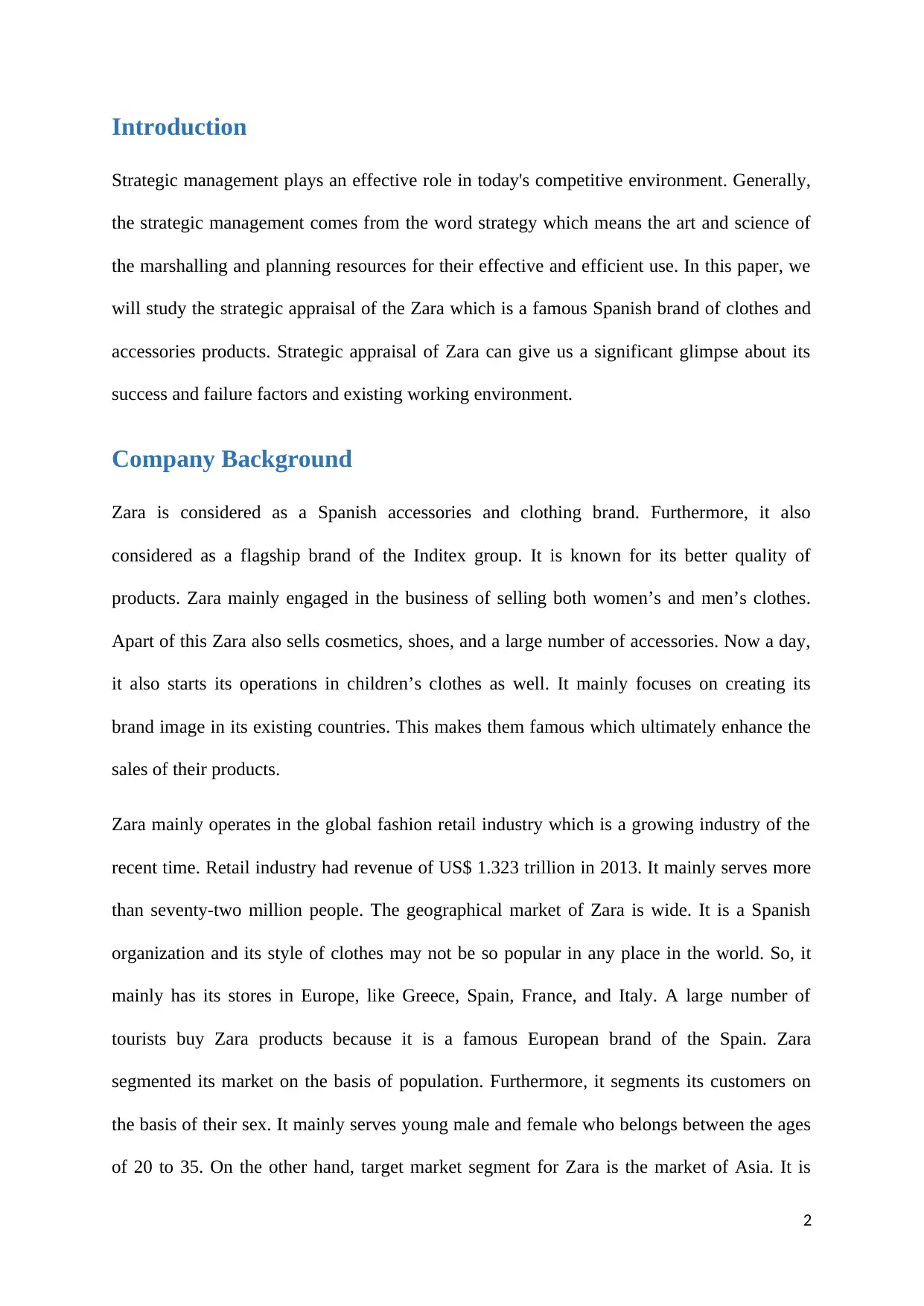
Introduction
Strategic management plays an effective role in today's competitive environment. Generally,
the strategic management comes from the word strategy which means the art and science of
the marshalling and planning resources for their effective and efficient use. In this paper, we
will study the strategic appraisal of the Zara which is a famous Spanish brand of clothes and
accessories products. Strategic appraisal of Zara can give us a significant glimpse about its
success and failure factors and existing working environment.
Company Background
Zara is considered as a Spanish accessories and clothing brand. Furthermore, it also
considered as a flagship brand of the Inditex group. It is known for its better quality of
products. Zara mainly engaged in the business of selling both women’s and men’s clothes.
Apart of this Zara also sells cosmetics, shoes, and a large number of accessories. Now a day,
it also starts its operations in children’s clothes as well. It mainly focuses on creating its
brand image in its existing countries. This makes them famous which ultimately enhance the
sales of their products.
Zara mainly operates in the global fashion retail industry which is a growing industry of the
recent time. Retail industry had revenue of US$ 1.323 trillion in 2013. It mainly serves more
than seventy-two million people. The geographical market of Zara is wide. It is a Spanish
organization and its style of clothes may not be so popular in any place in the world. So, it
mainly has its stores in Europe, like Greece, Spain, France, and Italy. A large number of
tourists buy Zara products because it is a famous European brand of the Spain. Zara
segmented its market on the basis of population. Furthermore, it segments its customers on
the basis of their sex. It mainly serves young male and female who belongs between the ages
of 20 to 35. On the other hand, target market segment for Zara is the market of Asia. It is
2
Strategic management plays an effective role in today's competitive environment. Generally,
the strategic management comes from the word strategy which means the art and science of
the marshalling and planning resources for their effective and efficient use. In this paper, we
will study the strategic appraisal of the Zara which is a famous Spanish brand of clothes and
accessories products. Strategic appraisal of Zara can give us a significant glimpse about its
success and failure factors and existing working environment.
Company Background
Zara is considered as a Spanish accessories and clothing brand. Furthermore, it also
considered as a flagship brand of the Inditex group. It is known for its better quality of
products. Zara mainly engaged in the business of selling both women’s and men’s clothes.
Apart of this Zara also sells cosmetics, shoes, and a large number of accessories. Now a day,
it also starts its operations in children’s clothes as well. It mainly focuses on creating its
brand image in its existing countries. This makes them famous which ultimately enhance the
sales of their products.
Zara mainly operates in the global fashion retail industry which is a growing industry of the
recent time. Retail industry had revenue of US$ 1.323 trillion in 2013. It mainly serves more
than seventy-two million people. The geographical market of Zara is wide. It is a Spanish
organization and its style of clothes may not be so popular in any place in the world. So, it
mainly has its stores in Europe, like Greece, Spain, France, and Italy. A large number of
tourists buy Zara products because it is a famous European brand of the Spain. Zara
segmented its market on the basis of population. Furthermore, it segments its customers on
the basis of their sex. It mainly serves young male and female who belongs between the ages
of 20 to 35. On the other hand, target market segment for Zara is the market of Asia. It is
2
⊘ This is a preview!⊘
Do you want full access?
Subscribe today to unlock all pages.

Trusted by 1+ million students worldwide
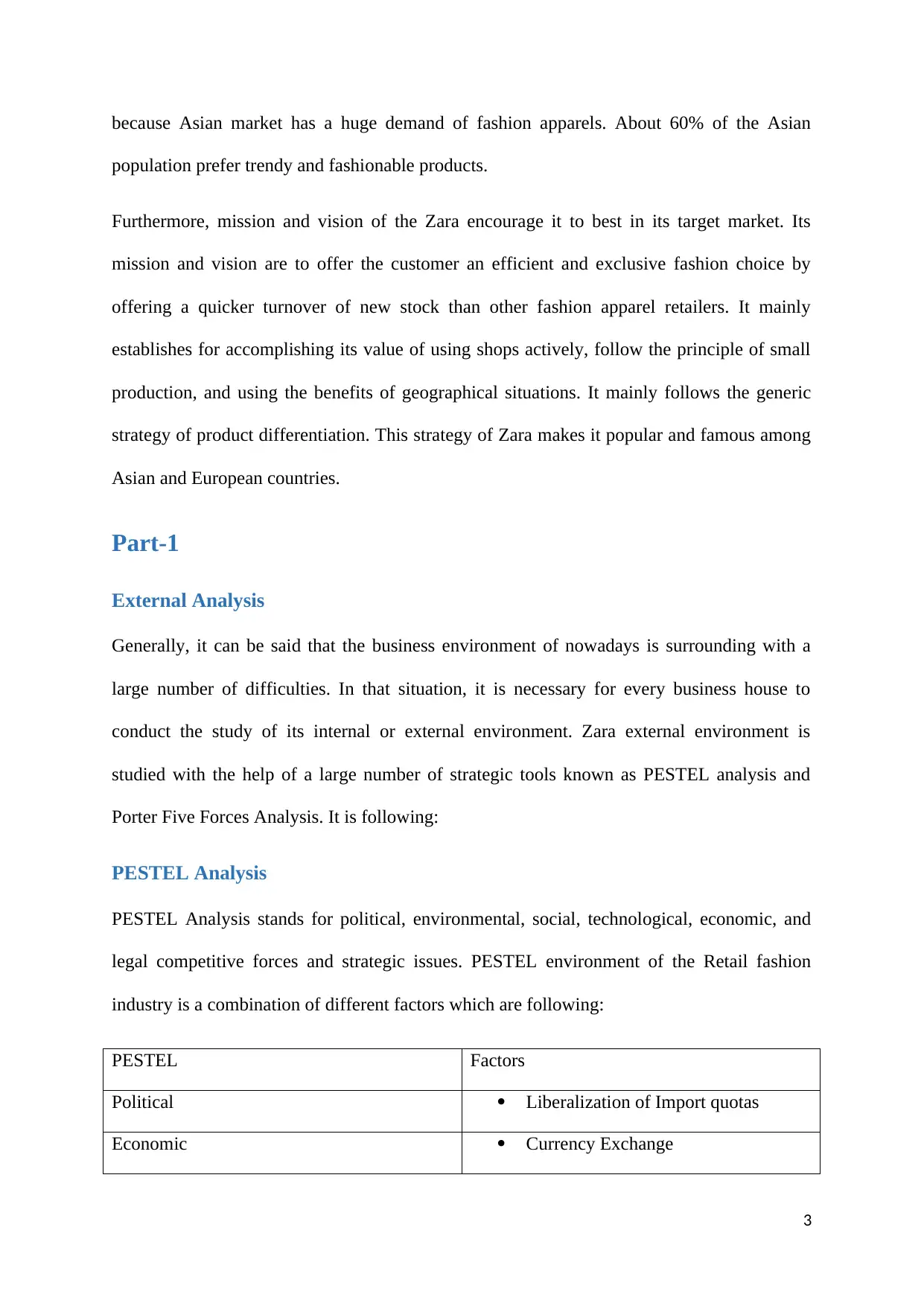
because Asian market has a huge demand of fashion apparels. About 60% of the Asian
population prefer trendy and fashionable products.
Furthermore, mission and vision of the Zara encourage it to best in its target market. Its
mission and vision are to offer the customer an efficient and exclusive fashion choice by
offering a quicker turnover of new stock than other fashion apparel retailers. It mainly
establishes for accomplishing its value of using shops actively, follow the principle of small
production, and using the benefits of geographical situations. It mainly follows the generic
strategy of product differentiation. This strategy of Zara makes it popular and famous among
Asian and European countries.
Part-1
External Analysis
Generally, it can be said that the business environment of nowadays is surrounding with a
large number of difficulties. In that situation, it is necessary for every business house to
conduct the study of its internal or external environment. Zara external environment is
studied with the help of a large number of strategic tools known as PESTEL analysis and
Porter Five Forces Analysis. It is following:
PESTEL Analysis
PESTEL Analysis stands for political, environmental, social, technological, economic, and
legal competitive forces and strategic issues. PESTEL environment of the Retail fashion
industry is a combination of different factors which are following:
PESTEL Factors
Political Liberalization of Import quotas
Economic Currency Exchange
3
population prefer trendy and fashionable products.
Furthermore, mission and vision of the Zara encourage it to best in its target market. Its
mission and vision are to offer the customer an efficient and exclusive fashion choice by
offering a quicker turnover of new stock than other fashion apparel retailers. It mainly
establishes for accomplishing its value of using shops actively, follow the principle of small
production, and using the benefits of geographical situations. It mainly follows the generic
strategy of product differentiation. This strategy of Zara makes it popular and famous among
Asian and European countries.
Part-1
External Analysis
Generally, it can be said that the business environment of nowadays is surrounding with a
large number of difficulties. In that situation, it is necessary for every business house to
conduct the study of its internal or external environment. Zara external environment is
studied with the help of a large number of strategic tools known as PESTEL analysis and
Porter Five Forces Analysis. It is following:
PESTEL Analysis
PESTEL Analysis stands for political, environmental, social, technological, economic, and
legal competitive forces and strategic issues. PESTEL environment of the Retail fashion
industry is a combination of different factors which are following:
PESTEL Factors
Political Liberalization of Import quotas
Economic Currency Exchange
3
Paraphrase This Document
Need a fresh take? Get an instant paraphrase of this document with our AI Paraphraser

Sensitivity of Price
Functioning in different countries
Social Huge growth in Asia
Limited in North and Europe
Legal Changes in Laws of tax
Size of Government budgets (Weaver,
2014)
Antitrust Legislation
Technological Concentration on existing
technologies
Implementation of innovative and
attractive technologies.
Environment Social responsibility
Political
It can be said that fundamental political factors of managing the overall country and political
stability may affect the fashion retail industry in a greater manner. It is said that the
liberalization of import quotas influence the overall industry in a positive manner. But this is
highly beneficial for the euro zone. Offering aid in poor areas and building a large number of
social relationships in different developed and developing countries has offered Zara and
other fashion organizations a positive image in the international political environment.
Economic
4
Functioning in different countries
Social Huge growth in Asia
Limited in North and Europe
Legal Changes in Laws of tax
Size of Government budgets (Weaver,
2014)
Antitrust Legislation
Technological Concentration on existing
technologies
Implementation of innovative and
attractive technologies.
Environment Social responsibility
Political
It can be said that fundamental political factors of managing the overall country and political
stability may affect the fashion retail industry in a greater manner. It is said that the
liberalization of import quotas influence the overall industry in a positive manner. But this is
highly beneficial for the euro zone. Offering aid in poor areas and building a large number of
social relationships in different developed and developing countries has offered Zara and
other fashion organizations a positive image in the international political environment.
Economic
4
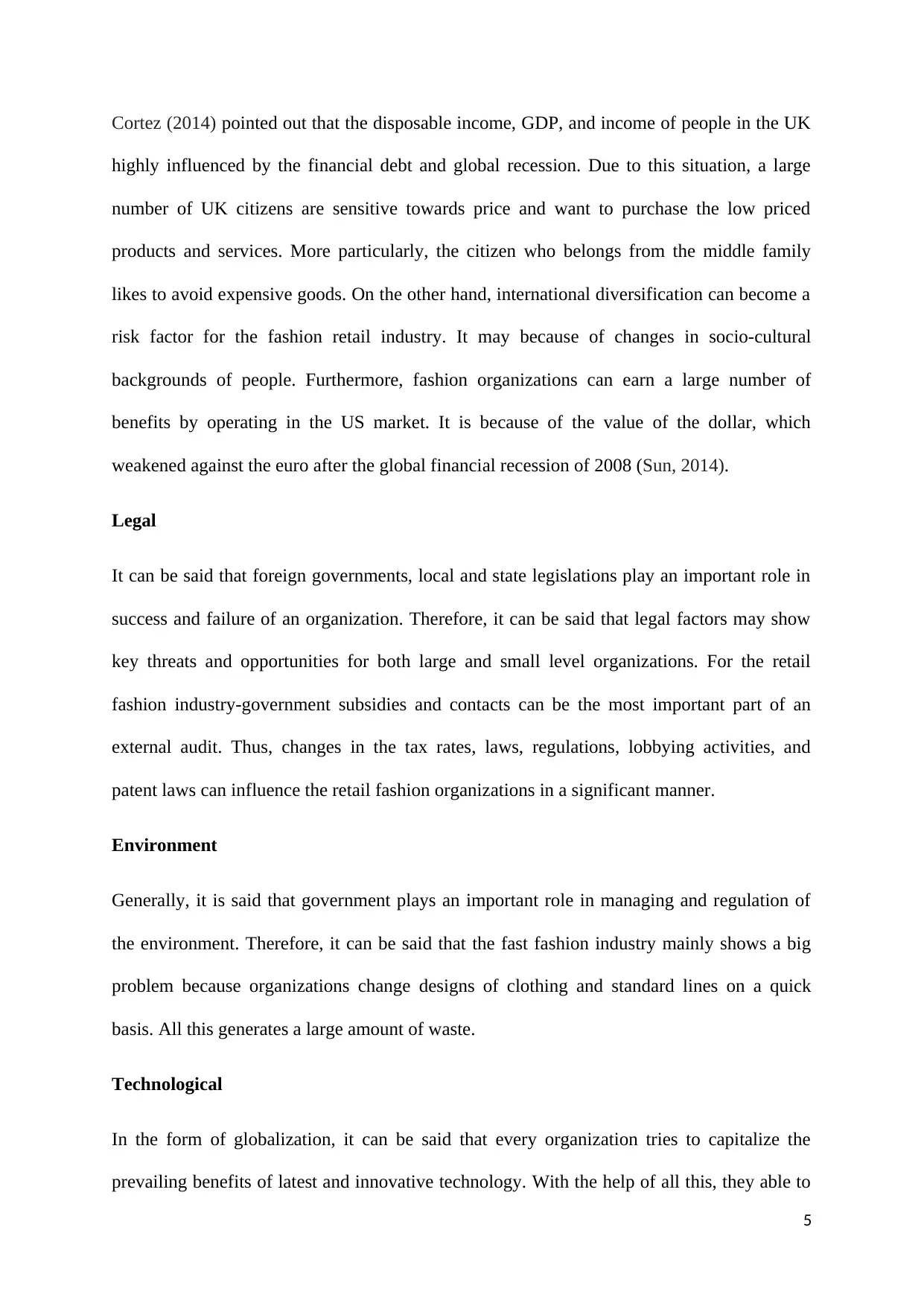
Cortez (2014) pointed out that the disposable income, GDP, and income of people in the UK
highly influenced by the financial debt and global recession. Due to this situation, a large
number of UK citizens are sensitive towards price and want to purchase the low priced
products and services. More particularly, the citizen who belongs from the middle family
likes to avoid expensive goods. On the other hand, international diversification can become a
risk factor for the fashion retail industry. It may because of changes in socio-cultural
backgrounds of people. Furthermore, fashion organizations can earn a large number of
benefits by operating in the US market. It is because of the value of the dollar, which
weakened against the euro after the global financial recession of 2008 (Sun, 2014).
Legal
It can be said that foreign governments, local and state legislations play an important role in
success and failure of an organization. Therefore, it can be said that legal factors may show
key threats and opportunities for both large and small level organizations. For the retail
fashion industry-government subsidies and contacts can be the most important part of an
external audit. Thus, changes in the tax rates, laws, regulations, lobbying activities, and
patent laws can influence the retail fashion organizations in a significant manner.
Environment
Generally, it is said that government plays an important role in managing and regulation of
the environment. Therefore, it can be said that the fast fashion industry mainly shows a big
problem because organizations change designs of clothing and standard lines on a quick
basis. All this generates a large amount of waste.
Technological
In the form of globalization, it can be said that every organization tries to capitalize the
prevailing benefits of latest and innovative technology. With the help of all this, they able to
5
highly influenced by the financial debt and global recession. Due to this situation, a large
number of UK citizens are sensitive towards price and want to purchase the low priced
products and services. More particularly, the citizen who belongs from the middle family
likes to avoid expensive goods. On the other hand, international diversification can become a
risk factor for the fashion retail industry. It may because of changes in socio-cultural
backgrounds of people. Furthermore, fashion organizations can earn a large number of
benefits by operating in the US market. It is because of the value of the dollar, which
weakened against the euro after the global financial recession of 2008 (Sun, 2014).
Legal
It can be said that foreign governments, local and state legislations play an important role in
success and failure of an organization. Therefore, it can be said that legal factors may show
key threats and opportunities for both large and small level organizations. For the retail
fashion industry-government subsidies and contacts can be the most important part of an
external audit. Thus, changes in the tax rates, laws, regulations, lobbying activities, and
patent laws can influence the retail fashion organizations in a significant manner.
Environment
Generally, it is said that government plays an important role in managing and regulation of
the environment. Therefore, it can be said that the fast fashion industry mainly shows a big
problem because organizations change designs of clothing and standard lines on a quick
basis. All this generates a large amount of waste.
Technological
In the form of globalization, it can be said that every organization tries to capitalize the
prevailing benefits of latest and innovative technology. With the help of all this, they able to
5
⊘ This is a preview!⊘
Do you want full access?
Subscribe today to unlock all pages.

Trusted by 1+ million students worldwide
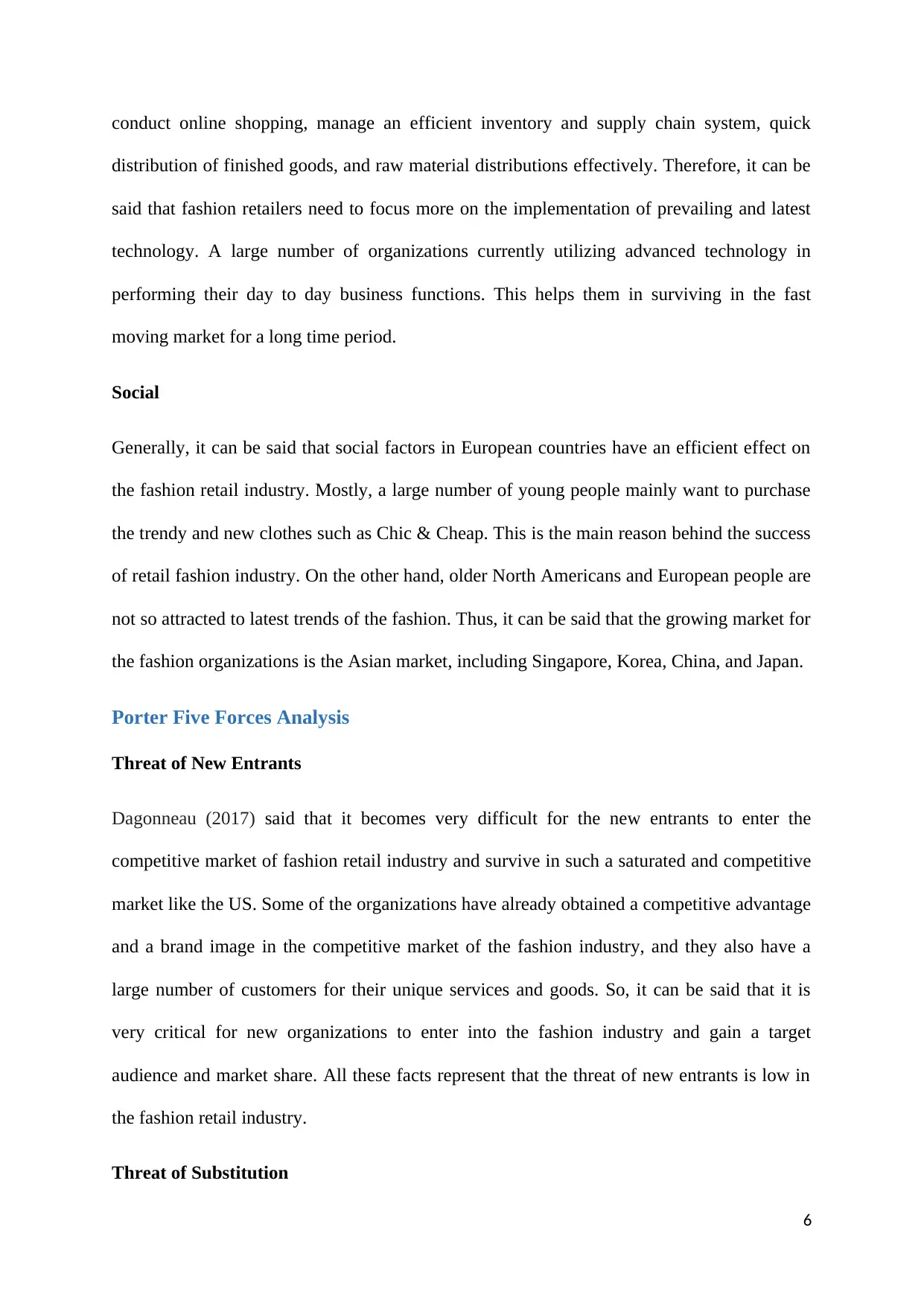
conduct online shopping, manage an efficient inventory and supply chain system, quick
distribution of finished goods, and raw material distributions effectively. Therefore, it can be
said that fashion retailers need to focus more on the implementation of prevailing and latest
technology. A large number of organizations currently utilizing advanced technology in
performing their day to day business functions. This helps them in surviving in the fast
moving market for a long time period.
Social
Generally, it can be said that social factors in European countries have an efficient effect on
the fashion retail industry. Mostly, a large number of young people mainly want to purchase
the trendy and new clothes such as Chic & Cheap. This is the main reason behind the success
of retail fashion industry. On the other hand, older North Americans and European people are
not so attracted to latest trends of the fashion. Thus, it can be said that the growing market for
the fashion organizations is the Asian market, including Singapore, Korea, China, and Japan.
Porter Five Forces Analysis
Threat of New Entrants
Dagonneau (2017) said that it becomes very difficult for the new entrants to enter the
competitive market of fashion retail industry and survive in such a saturated and competitive
market like the US. Some of the organizations have already obtained a competitive advantage
and a brand image in the competitive market of the fashion industry, and they also have a
large number of customers for their unique services and goods. So, it can be said that it is
very critical for new organizations to enter into the fashion industry and gain a target
audience and market share. All these facts represent that the threat of new entrants is low in
the fashion retail industry.
Threat of Substitution
6
distribution of finished goods, and raw material distributions effectively. Therefore, it can be
said that fashion retailers need to focus more on the implementation of prevailing and latest
technology. A large number of organizations currently utilizing advanced technology in
performing their day to day business functions. This helps them in surviving in the fast
moving market for a long time period.
Social
Generally, it can be said that social factors in European countries have an efficient effect on
the fashion retail industry. Mostly, a large number of young people mainly want to purchase
the trendy and new clothes such as Chic & Cheap. This is the main reason behind the success
of retail fashion industry. On the other hand, older North Americans and European people are
not so attracted to latest trends of the fashion. Thus, it can be said that the growing market for
the fashion organizations is the Asian market, including Singapore, Korea, China, and Japan.
Porter Five Forces Analysis
Threat of New Entrants
Dagonneau (2017) said that it becomes very difficult for the new entrants to enter the
competitive market of fashion retail industry and survive in such a saturated and competitive
market like the US. Some of the organizations have already obtained a competitive advantage
and a brand image in the competitive market of the fashion industry, and they also have a
large number of customers for their unique services and goods. So, it can be said that it is
very critical for new organizations to enter into the fashion industry and gain a target
audience and market share. All these facts represent that the threat of new entrants is low in
the fashion retail industry.
Threat of Substitution
6
Paraphrase This Document
Need a fresh take? Get an instant paraphrase of this document with our AI Paraphraser
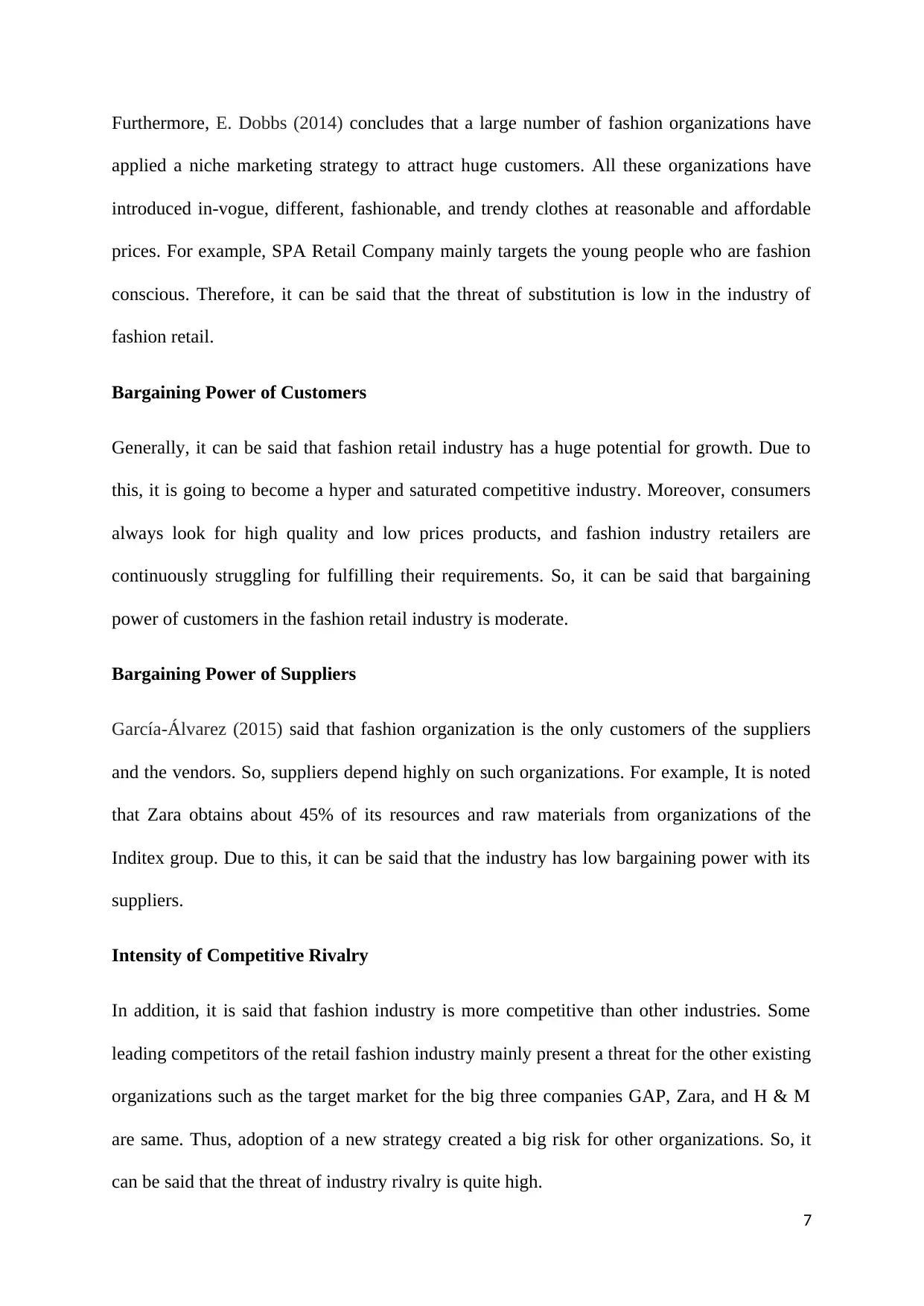
Furthermore, E. Dobbs (2014) concludes that a large number of fashion organizations have
applied a niche marketing strategy to attract huge customers. All these organizations have
introduced in-vogue, different, fashionable, and trendy clothes at reasonable and affordable
prices. For example, SPA Retail Company mainly targets the young people who are fashion
conscious. Therefore, it can be said that the threat of substitution is low in the industry of
fashion retail.
Bargaining Power of Customers
Generally, it can be said that fashion retail industry has a huge potential for growth. Due to
this, it is going to become a hyper and saturated competitive industry. Moreover, consumers
always look for high quality and low prices products, and fashion industry retailers are
continuously struggling for fulfilling their requirements. So, it can be said that bargaining
power of customers in the fashion retail industry is moderate.
Bargaining Power of Suppliers
García-Álvarez (2015) said that fashion organization is the only customers of the suppliers
and the vendors. So, suppliers depend highly on such organizations. For example, It is noted
that Zara obtains about 45% of its resources and raw materials from organizations of the
Inditex group. Due to this, it can be said that the industry has low bargaining power with its
suppliers.
Intensity of Competitive Rivalry
In addition, it is said that fashion industry is more competitive than other industries. Some
leading competitors of the retail fashion industry mainly present a threat for the other existing
organizations such as the target market for the big three companies GAP, Zara, and H & M
are same. Thus, adoption of a new strategy created a big risk for other organizations. So, it
can be said that the threat of industry rivalry is quite high.
7
applied a niche marketing strategy to attract huge customers. All these organizations have
introduced in-vogue, different, fashionable, and trendy clothes at reasonable and affordable
prices. For example, SPA Retail Company mainly targets the young people who are fashion
conscious. Therefore, it can be said that the threat of substitution is low in the industry of
fashion retail.
Bargaining Power of Customers
Generally, it can be said that fashion retail industry has a huge potential for growth. Due to
this, it is going to become a hyper and saturated competitive industry. Moreover, consumers
always look for high quality and low prices products, and fashion industry retailers are
continuously struggling for fulfilling their requirements. So, it can be said that bargaining
power of customers in the fashion retail industry is moderate.
Bargaining Power of Suppliers
García-Álvarez (2015) said that fashion organization is the only customers of the suppliers
and the vendors. So, suppliers depend highly on such organizations. For example, It is noted
that Zara obtains about 45% of its resources and raw materials from organizations of the
Inditex group. Due to this, it can be said that the industry has low bargaining power with its
suppliers.
Intensity of Competitive Rivalry
In addition, it is said that fashion industry is more competitive than other industries. Some
leading competitors of the retail fashion industry mainly present a threat for the other existing
organizations such as the target market for the big three companies GAP, Zara, and H & M
are same. Thus, adoption of a new strategy created a big risk for other organizations. So, it
can be said that the threat of industry rivalry is quite high.
7
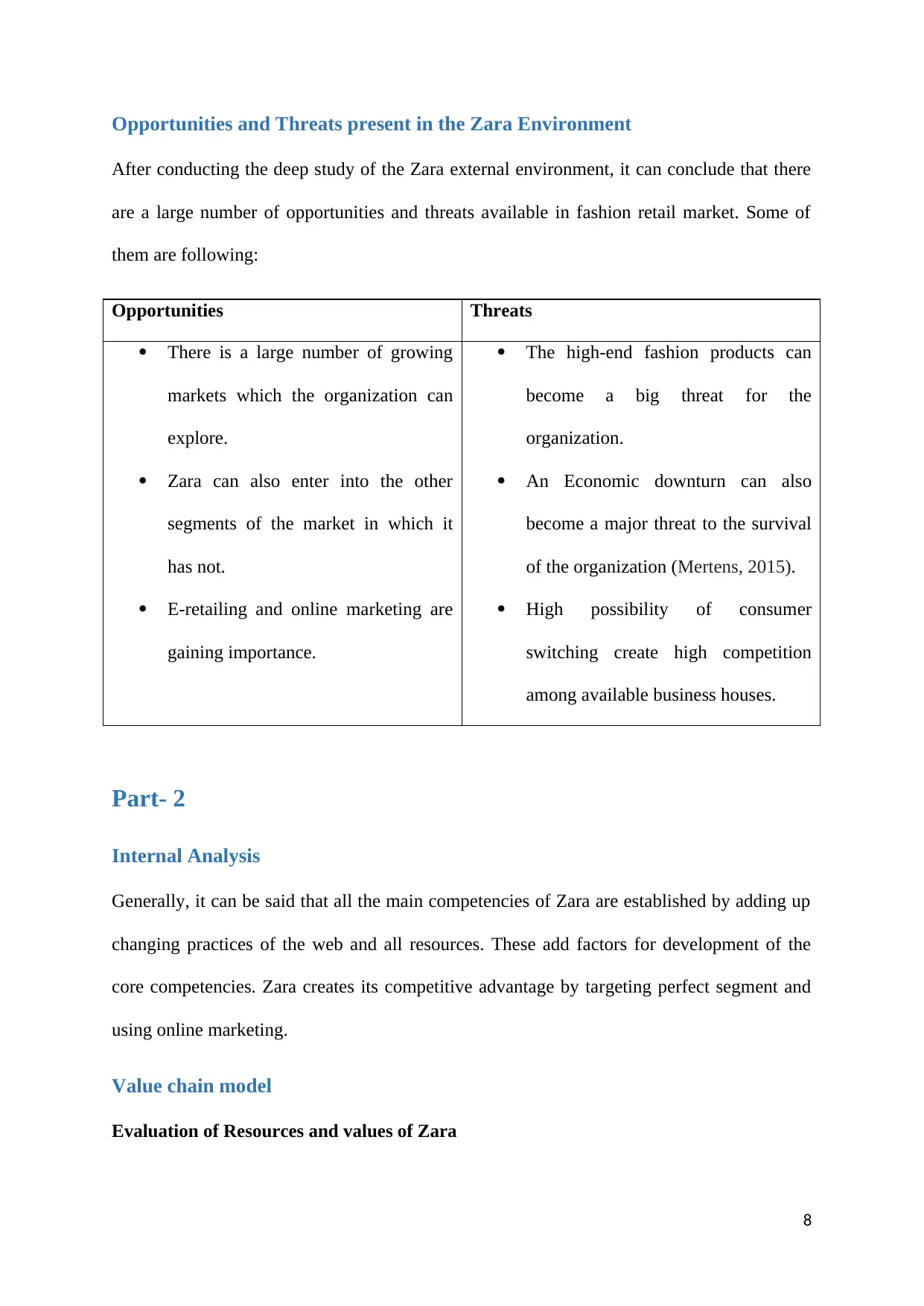
Opportunities and Threats present in the Zara Environment
After conducting the deep study of the Zara external environment, it can conclude that there
are a large number of opportunities and threats available in fashion retail market. Some of
them are following:
Opportunities Threats
There is a large number of growing
markets which the organization can
explore.
Zara can also enter into the other
segments of the market in which it
has not.
E-retailing and online marketing are
gaining importance.
The high-end fashion products can
become a big threat for the
organization.
An Economic downturn can also
become a major threat to the survival
of the organization (Mertens, 2015).
High possibility of consumer
switching create high competition
among available business houses.
Part- 2
Internal Analysis
Generally, it can be said that all the main competencies of Zara are established by adding up
changing practices of the web and all resources. These add factors for development of the
core competencies. Zara creates its competitive advantage by targeting perfect segment and
using online marketing.
Value chain model
Evaluation of Resources and values of Zara
8
After conducting the deep study of the Zara external environment, it can conclude that there
are a large number of opportunities and threats available in fashion retail market. Some of
them are following:
Opportunities Threats
There is a large number of growing
markets which the organization can
explore.
Zara can also enter into the other
segments of the market in which it
has not.
E-retailing and online marketing are
gaining importance.
The high-end fashion products can
become a big threat for the
organization.
An Economic downturn can also
become a major threat to the survival
of the organization (Mertens, 2015).
High possibility of consumer
switching create high competition
among available business houses.
Part- 2
Internal Analysis
Generally, it can be said that all the main competencies of Zara are established by adding up
changing practices of the web and all resources. These add factors for development of the
core competencies. Zara creates its competitive advantage by targeting perfect segment and
using online marketing.
Value chain model
Evaluation of Resources and values of Zara
8
⊘ This is a preview!⊘
Do you want full access?
Subscribe today to unlock all pages.

Trusted by 1+ million students worldwide
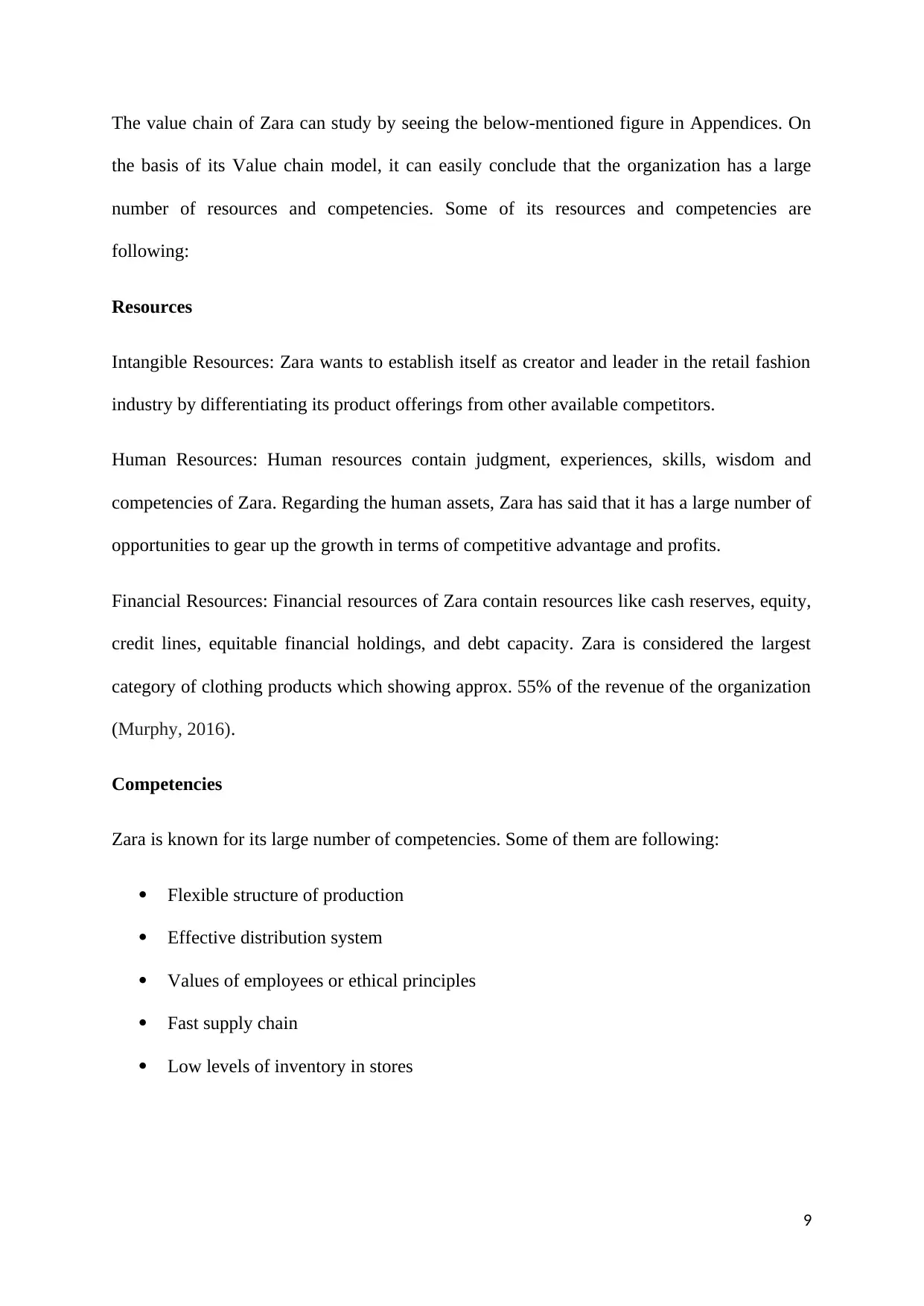
The value chain of Zara can study by seeing the below-mentioned figure in Appendices. On
the basis of its Value chain model, it can easily conclude that the organization has a large
number of resources and competencies. Some of its resources and competencies are
following:
Resources
Intangible Resources: Zara wants to establish itself as creator and leader in the retail fashion
industry by differentiating its product offerings from other available competitors.
Human Resources: Human resources contain judgment, experiences, skills, wisdom and
competencies of Zara. Regarding the human assets, Zara has said that it has a large number of
opportunities to gear up the growth in terms of competitive advantage and profits.
Financial Resources: Financial resources of Zara contain resources like cash reserves, equity,
credit lines, equitable financial holdings, and debt capacity. Zara is considered the largest
category of clothing products which showing approx. 55% of the revenue of the organization
(Murphy, 2016).
Competencies
Zara is known for its large number of competencies. Some of them are following:
Flexible structure of production
Effective distribution system
Values of employees or ethical principles
Fast supply chain
Low levels of inventory in stores
9
the basis of its Value chain model, it can easily conclude that the organization has a large
number of resources and competencies. Some of its resources and competencies are
following:
Resources
Intangible Resources: Zara wants to establish itself as creator and leader in the retail fashion
industry by differentiating its product offerings from other available competitors.
Human Resources: Human resources contain judgment, experiences, skills, wisdom and
competencies of Zara. Regarding the human assets, Zara has said that it has a large number of
opportunities to gear up the growth in terms of competitive advantage and profits.
Financial Resources: Financial resources of Zara contain resources like cash reserves, equity,
credit lines, equitable financial holdings, and debt capacity. Zara is considered the largest
category of clothing products which showing approx. 55% of the revenue of the organization
(Murphy, 2016).
Competencies
Zara is known for its large number of competencies. Some of them are following:
Flexible structure of production
Effective distribution system
Values of employees or ethical principles
Fast supply chain
Low levels of inventory in stores
9
Paraphrase This Document
Need a fresh take? Get an instant paraphrase of this document with our AI Paraphraser

Competency framework
Competency framework of Zara can understand by looking the figure mentioned in the
Appendices section of the paper. After studying its competency framework, it can be said that
threshold and distinctive resources and capabilities of the organization are significantly
different from each other. Threshold resources like tangible and intangible resources make it
separate from the threshold competencies. On the other hand, distinctive competencies of
Zara which make it separate from others like brand image, high quality, and latest. These
distinctive competencies can't offer by other organizations like GAP (Greenfield, 2015).
Distinctive competencies of the organization enforce it to achieve competitive advantage in
its existing market. That's why Zara has a separate name and brand identity among existing
markets.
VRIO Framework
VRIO framework of the Zara can study by looking the figure mentioned in the Appendices section of
the paper. VRIO framework is a combination of four main elements which are following:
Value: Generally, it can be said that Zara is a combination of a large number of resources. Due to this,
it can be said that the most valuable resource of the Zara is the vertical integration. Instead of
depending on third parties, Zara manages all its operations like design, logistics, warehousing, and
distribution itself. Due to this, it is more valuable and flexible rather than its competitors.
Rareness: Most of the Zara competitor uses outsource the process to improve their functioning. But,
Zara doesn't do this. It does its opposite. It focuses more on the capital-intensive industry. Due to this,
it able to produces unique products which maintain its rarity among competitive environment.
Imitability: Nowadays everything becomes imitable. Zara business model is imitable in nature. It is
because competitors of Zara can copy its model only in the case of a long run. Copying business
model of Zara consumes a huge time of competitors.
10
Competency framework of Zara can understand by looking the figure mentioned in the
Appendices section of the paper. After studying its competency framework, it can be said that
threshold and distinctive resources and capabilities of the organization are significantly
different from each other. Threshold resources like tangible and intangible resources make it
separate from the threshold competencies. On the other hand, distinctive competencies of
Zara which make it separate from others like brand image, high quality, and latest. These
distinctive competencies can't offer by other organizations like GAP (Greenfield, 2015).
Distinctive competencies of the organization enforce it to achieve competitive advantage in
its existing market. That's why Zara has a separate name and brand identity among existing
markets.
VRIO Framework
VRIO framework of the Zara can study by looking the figure mentioned in the Appendices section of
the paper. VRIO framework is a combination of four main elements which are following:
Value: Generally, it can be said that Zara is a combination of a large number of resources. Due to this,
it can be said that the most valuable resource of the Zara is the vertical integration. Instead of
depending on third parties, Zara manages all its operations like design, logistics, warehousing, and
distribution itself. Due to this, it is more valuable and flexible rather than its competitors.
Rareness: Most of the Zara competitor uses outsource the process to improve their functioning. But,
Zara doesn't do this. It does its opposite. It focuses more on the capital-intensive industry. Due to this,
it able to produces unique products which maintain its rarity among competitive environment.
Imitability: Nowadays everything becomes imitable. Zara business model is imitable in nature. It is
because competitors of Zara can copy its model only in the case of a long run. Copying business
model of Zara consumes a huge time of competitors.
10
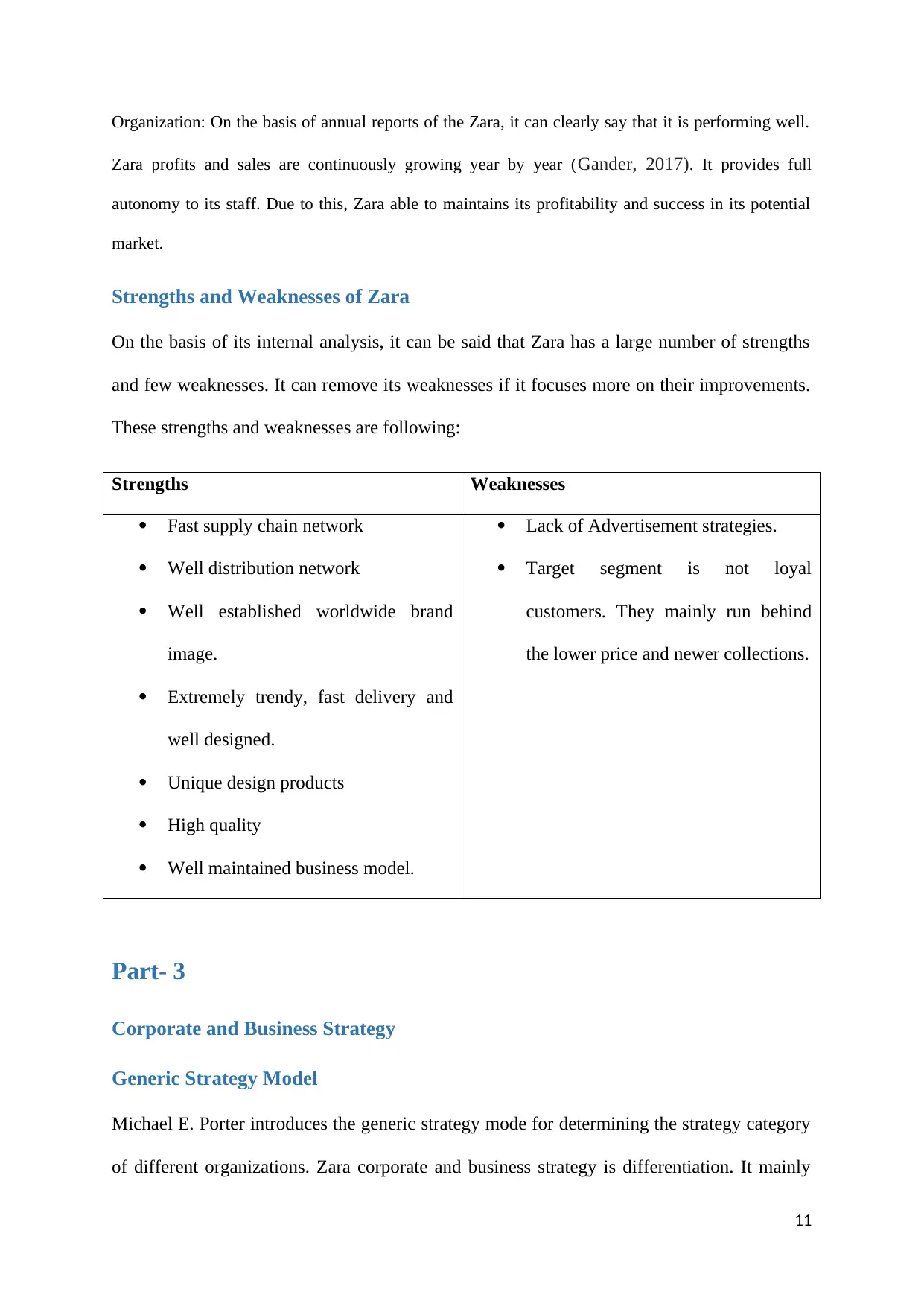
Organization: On the basis of annual reports of the Zara, it can clearly say that it is performing well.
Zara profits and sales are continuously growing year by year (Gander, 2017). It provides full
autonomy to its staff. Due to this, Zara able to maintains its profitability and success in its potential
market.
Strengths and Weaknesses of Zara
On the basis of its internal analysis, it can be said that Zara has a large number of strengths
and few weaknesses. It can remove its weaknesses if it focuses more on their improvements.
These strengths and weaknesses are following:
Strengths Weaknesses
Fast supply chain network
Well distribution network
Well established worldwide brand
image.
Extremely trendy, fast delivery and
well designed.
Unique design products
High quality
Well maintained business model.
Lack of Advertisement strategies.
Target segment is not loyal
customers. They mainly run behind
the lower price and newer collections.
Part- 3
Corporate and Business Strategy
Generic Strategy Model
Michael E. Porter introduces the generic strategy mode for determining the strategy category
of different organizations. Zara corporate and business strategy is differentiation. It mainly
11
Zara profits and sales are continuously growing year by year (Gander, 2017). It provides full
autonomy to its staff. Due to this, Zara able to maintains its profitability and success in its potential
market.
Strengths and Weaknesses of Zara
On the basis of its internal analysis, it can be said that Zara has a large number of strengths
and few weaknesses. It can remove its weaknesses if it focuses more on their improvements.
These strengths and weaknesses are following:
Strengths Weaknesses
Fast supply chain network
Well distribution network
Well established worldwide brand
image.
Extremely trendy, fast delivery and
well designed.
Unique design products
High quality
Well maintained business model.
Lack of Advertisement strategies.
Target segment is not loyal
customers. They mainly run behind
the lower price and newer collections.
Part- 3
Corporate and Business Strategy
Generic Strategy Model
Michael E. Porter introduces the generic strategy mode for determining the strategy category
of different organizations. Zara corporate and business strategy is differentiation. It mainly
11
⊘ This is a preview!⊘
Do you want full access?
Subscribe today to unlock all pages.

Trusted by 1+ million students worldwide
1 out of 24
Related Documents
Your All-in-One AI-Powered Toolkit for Academic Success.
+13062052269
info@desklib.com
Available 24*7 on WhatsApp / Email
![[object Object]](/_next/static/media/star-bottom.7253800d.svg)
Unlock your academic potential
Copyright © 2020–2025 A2Z Services. All Rights Reserved. Developed and managed by ZUCOL.





